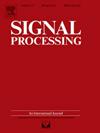Target localization with coprime multistatic MIMO radar via coupled canonical polyadic decomposition based on joint eigenvalue decomposition
IF 3.4
2区 工程技术
Q2 ENGINEERING, ELECTRICAL & ELECTRONIC
引用次数: 0
Abstract
This paper investigates target localization using a multistatic multiple-input multiple-output (MIMO) radar system with two distinct coprime array configurations: coprime L-shaped arrays and coprime planar arrays. The observed signals are modeled as tensors that admit a coupled canonical polyadic decomposition (C-CPD) model. For each configuration, a C-CPD method is presented based on joint eigenvalue decomposition (J-EVD). This computational framework includes (semi-)algebraic and optimization-based C-CPD algorithms and target localization that fuses direction-of-arrivals (DOAs) information to calculate the optimal position of each target. Specifically, the proposed (semi-)algebraic methods exploit the rotational invariance of the Vandermonde structure in coprime arrays, similar to the multiple invariance property of estimation of signal parameters via rotational invariance techniques (ESPRIT), which transforms the model into a J-EVD problem and reduces computational complexity. The study also investigates the working conditions of the algorithm to understand model identifiability. Additionally, the proposed method does not rely on prior knowledge of non-orthogonal probing waveforms and is effective in challenging underdetermined scenarios. Experimental results demonstrate that our method outperforms existing tensor-based approaches in both accuracy and computational efficiency.
基于联合特征值分解的耦合正则多进分解的同素数多静态MIMO雷达目标定位
本文研究了一种多源多输入多输出(MIMO)雷达系统的目标定位问题,该系统具有两种不同的同素数阵列:同素数l形阵列和同素数平面阵列。观测到的信号被建模为张量,承认一个耦合正则多进分解(C-CPD)模型。针对每种构型,提出了基于联合特征值分解(J-EVD)的C-CPD方法。该计算框架包括(半)代数和基于优化的C-CPD算法和目标定位,融合到达方向(DOAs)信息来计算每个目标的最佳位置。具体而言,所提出的(半)代数方法利用了互素阵列中Vandermonde结构的旋转不变性,类似于通过旋转不变性技术(ESPRIT)估计信号参数的多重不变性,将模型转化为J-EVD问题,降低了计算复杂度。研究还考察了算法的工作条件,以了解模型的可识别性。此外,该方法不依赖于非正交探测波形的先验知识,在挑战欠确定场景时有效。实验结果表明,该方法在精度和计算效率方面都优于现有的基于张量的方法。
本文章由计算机程序翻译,如有差异,请以英文原文为准。
求助全文
约1分钟内获得全文
求助全文
来源期刊

Signal Processing
工程技术-工程:电子与电气
CiteScore
9.20
自引率
9.10%
发文量
309
审稿时长
41 days
期刊介绍:
Signal Processing incorporates all aspects of the theory and practice of signal processing. It features original research work, tutorial and review articles, and accounts of practical developments. It is intended for a rapid dissemination of knowledge and experience to engineers and scientists working in the research, development or practical application of signal processing.
Subject areas covered by the journal include: Signal Theory; Stochastic Processes; Detection and Estimation; Spectral Analysis; Filtering; Signal Processing Systems; Software Developments; Image Processing; Pattern Recognition; Optical Signal Processing; Digital Signal Processing; Multi-dimensional Signal Processing; Communication Signal Processing; Biomedical Signal Processing; Geophysical and Astrophysical Signal Processing; Earth Resources Signal Processing; Acoustic and Vibration Signal Processing; Data Processing; Remote Sensing; Signal Processing Technology; Radar Signal Processing; Sonar Signal Processing; Industrial Applications; New Applications.
 求助内容:
求助内容: 应助结果提醒方式:
应助结果提醒方式:


